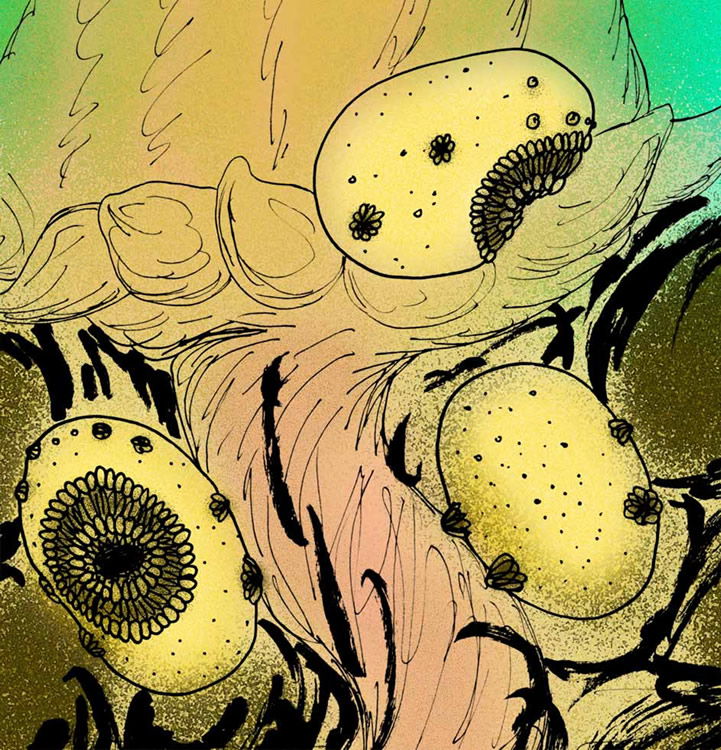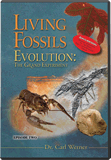
Was Our Oldest Itty-Bitty Ancestor All Mouth?
Abstract
Big mouth on a tiny ball speaks volumes about God’s design in all creatures great and small!
News Sources
- ScienceDaily: “Bag-Like Sea Creature Was Humans’ Oldest Known Ancestor”
- BBC: “Scientists Find “Oldest Human Ancestor””
- Guardian: “A Huge Mouth and No Anus—This Could Be Our Earliest Known Ancestor”
At-a-Glance
- Saccorhytus coronaries was a millimeter-sized animal that looked like a wrinkled bag with a large mouth but no anus.
- Fossils of Saccorhytus, part of the “Cambrian explosion,” are believed to represent a shared ancestor of all vertebrates and some invertebrates.
- Conical openings around the mouth of Saccorhytus supposedly evolved into the gills of larger and more complex animals.
- The small size of Sacchorhytus gives evolutionary scientists hope that the fossilized missing links to our deepest past are simply missing because they are so small.
- Saccorhytus illustrates some of God’s great designs in miniature, but it reveals nothing about our supposed molecules-to-man evolutionary ancestry.
Tiny black specks recovered from a lower Cambrian rock formation in South China’s Shaanxi Province have turned out to be the fossils of globular animals that once wriggled between grains of sediment. Discoverers have dubbed the small animal Saccorhytus coronaries because it has a sac-like body and a mouth surrounded by a corona (crown) of spikes. They have not located a separate digestive output opening on its other end. Therefore, it apparently ate and evacuated its waste through its mouth. Evolutionists say Saccorhytus could be the oldest known ancestor we share with elephants, sea bass, sharks, starfish, sea urchins, and acorn worms.
Jaw-Dropping Details
The anatomy unveiled in the nondescript black fossils by modern imaging technology is remarkable. “To the naked eye, the fossils we studied look like tiny black grains, but under the microscope the level of detail was jaw-dropping,” says University of Cambridge professor Simon Conway Morris, coauthor of the paper describing Saccorhytus.1
Only 1.3 millimeters long and less than a millimeter wide and high, Saccorhytus looks like a very wrinkled elliptical bag. Though rounded, the placement of its conical body appendages, pores, chevron-like folds, and mouth reveal it is bilaterally symmetrical. Surrounding its comparatively large mouth is a crown of conical openings, which scientists think might have served to expel water gulped with its food. Its body covering appears to have been a flexible one, allowing it to wriggle about as it ate. In addition to cones radiating from around its mouth, it has spines and two sets of pores. Scientists think some of the pores might have been sensory organs, but others might represent the attachment points for setae with which it could have intermittently anchored itself in seabed sediment.

Meet Saccorhytus coronaries, a tiny extinct animal recently discovered in Cambrian rock. Image by Apokryltaros, via Wikimedia Commons.
These Names Are A Mouthful
All vertebrates (animals with a backbone or at least a cartilaginous spinal column) and some invertebrates (like starfish and acorn worms) are classified as deuterostomes. This classification is based not on their supposed evolutionary history but on their embryologic development. The word deuterostome means “the mouth is second,” referring to the fact that the first opening to form in the embryonic digestive tract becomes the anus, and the second the mouth. (Animals whose embryos form a mouth from the first digestive tract opening are called protostomes. Earthworms, oysters, and many other invertebrates are protostomes.)
Sacchorhytus is classified as a deuterostome, not because scientists have studied its embryos, but because the folds and conical openings around its mouth resemble features in some other extinct deuterostomes.2 And although the word “deuterostome” seems to suggest all deuterostomes have digestive openings both fore and aft, some have only one. Saccorhytus seems to be one of these, though the authors admit the millimeter-sized animal has so many folds in its tiny wrinkled body that an anus might be eluding them.3
In any case, animals that have only one digestive opening cannot feed constantly. They must eat and digest their food, and then expel their waste material before they can eat again. Such animals’ digestive tracts also lack specialized sections designed to digest specific types of material, like the various parts of our gastrointestinal tract, or the extra stomachs in a ruminating cow. Some animals supposedly evolved a separate waste opening and later de-evolved their anus away. However, in general, animals with only a single digestive opening are considered more primitive, lower on the evolutionary scale, than those with two openings. Saccorhytus is, the authors believe, the oldest and simplest known deuterostome, the evolutionary forebear of all vertebrates and some invertebrates.
Supposed Ancestral Link Between Vertebrates and Many Invertebrates
The three tons of limestone from which the 45 Saccorhytus fossils were gleaned is supposedly 540 million years old. Such an age—if accurate—would make Saccorhytus older than other known deuterostomes. Other deuterostome fossils have been found in Cambrian sedimentary rock dated 510–520 million years old. Due to its greater age, and its resemblance to some more primitive-looking deuterostomes, evolutionary scientists believe they have found the oldest and most primitive deuterostome known to date, one that therefore should resemble the common ancestor they believe we share with all deuterostomes.
“All deuterostomes had a common ancestor, and we think that is what we are looking at here,” explains Morris, describing the evolutionary significance of their discovery.4 “In effect what we are suggesting here is that this is the earliest, oldest, most primitive of the deuterostomes. This is, if you like, the starting point of an evolution which led ultimately to things as different as a sea urchin, starfish and rabbit.”5 Coauthor Degan Shu says, “Saccorhytus now gives us remarkable insights into the very first stages of the evolution of a group that led to the fish, and ultimately, to us.”6
Billions of Dead Things Buried in Rock Layers, But No Transitional Gills
The Cambrian fossil record is called the “Cambrian explosion” to commemorate the curious event in which multicellular life abruptly diversified into virtually all major categories at about the same time. Cambrian strata are loaded with a wide variety of fossilized animals, including many deuterostomes. However, as the authors of the paper describing Saccorhytus note, “The Cambrian fossil record is well-populated with representative examples, but possible intermediates are controversial and the nature of the original deuterostome remains idealized.”7
The fossil record contains many kinds of dead things, but no fossils that demonstrate evolving complexity, evolutionary transitions between completely different kinds of animals.
The same can be said of the rest of the fossil record. The fossil record contains many kinds of dead things, but no fossils that demonstrate evolving complexity, evolutionary transitions between completely different kinds of animals. One of the many transitions evolutionists search for deep in the fossil record is the origin of gills. Because the folds and conical openings on Saccorhytus resemble the gill slits on some other Cambrian deuterostomes, scientists believe these openings evolved into gills as Saccorhytus’s evolutionary descendants made their way up the evolutionary ladder toward our supposed fishy ancestors. However, the folds and conical holes in Saccorhytus doubtless had their own functions. Scientists believe Saccorhytus was small enough to get the oxygen it needed without gills.
Structures that are—based on superficial appearance—commonly called “gill slits” in human embryos have nothing to do with any sort of respiratory function and are not even slits, just folds. Similarly, the superficial resemblance of these undiagnosed anatomical features in Saccorhytus fossils to gill slits in a different animal is not evidence that they evolved into gills. The function of these structures in Saccorhytus is not yet known, but evidently these are simply two different sorts of animals that obtained their oxygen in different ways. There are no transitions in view here. No transitional form of gills. And no evidence of transitions that could make rabbits and sea urchins from little bits of elliptical living grit, not even in half a billion years.
Small Enough to Resolve the Rock Clock/Molecular Clock Mismatch?
Finally, evolutionists are hopeful that the discovery of Saccorhytus in strata believed to be so much older than previously known deuterostomes alludes to the solution to a bigger problem. They hope Saccorhytus’s small size shows a way to bridge the discrepancy between molecular clock estimates of when multicellular life evolved and the ages of the earliest known multicellular life forms in the fossil record.
Evolutionary molecular clocks are based on the number of genetic differences between organisms believed to be related and the presumed rate at which such differences might accumulate through mutation. However, biologists have neither observed one kind of animal evolving into a new and more complex kind of animal nor seen mutations accumulate to produce new more complex genetic information of the type necessary for molecules-to-man evolution. Therefore, evolutionary molecular clocks predict the time it took for imaginary events to occur through imaginary means.
Knowing when something happened is essential to understanding history.
Even though riddled with many of the same assumptions that plague the evolutionary interpretation of the fossil record, molecular-clock estimates of when life evolved and diversified go back farther than evolutionary interpretations of the fossil record suggest. According to the evolutionary interpretation of the fossil record known as the Cambrian explosion, by 510–520 million years ago, deuterostomes had already evolved and diversified into a remarkable variety of very different sorts of organisms ranging from members of the starfish family to vertebrates to creatures scientists still struggle to classify. Molecular clock estimates of when multicellular animals evolved, however, point to an origin “tens to hundreds of millions of years earlier than their first appearances in the fossil record.”8 And even that amount of unaccounted for time seems much too brief to explain the rapid divergence of life’s first multicellular life into the plethora of creatures seen in the Cambrian explosion.
“Knowing when something happened is essential to understanding history,”9 as one evolutionary writer has succinctly declared. This molecular clock/fossil record mismatch is therefore a time gap that troubles many believers in an evolutionary history. The key clue to bridging this gap and guessing what happened during it, the discoverers of Saccorhtyus say, is the tiny size of these primitive fossils. Their tiny size suggests that multicellular life evolved in miniature, hidden in between the grains of grit comprising seabeds. The presumed diverging transitional forms and evolutionary descendants of such tiny organisms might have escaped fossilization, making hard evidence of that grand event very difficult to come by.
As the authors of the Saccorhytus study explain, “The discrepancy between the known fossil record of early metazoans and their estimated times of divergence as based on molecular clocks suggests that such miniaturized forms could slip through the nets of most fossilization pathways and so help to explain this cryptic history.”10 Conway Morris explains, “If indeed the first of these animals including Saccorhytus were very, very tiny, they could only preserve in very, very exceptional circumstances—they basically slip through the fossilisation net. . . . The question here of course is: is it possible that there is a deep cryptic history that has almost entirely eluded discovery because these things are absolutely tiny?”11
We believe a better question would be whether this evolutionary history is a fantasy. The evolutionary version of life’s origins is rooted not in scientific observations of evolving complexity and divergence but rather in the belief that only random natural processes could produce the variety of life seen in the fossil record and in the world around us today. The history provided to us in the Bible by the Creator God, the only eyewitness to life’s origins, is consistent with observational science but not with molecules-to-man evolutionary tales.
God’s Designs In Miniature
Without doubt, Saccorhytus is a fascinating discovery. Discovering detailed anatomy in such a small animal extracted from limestone rock is an impressive feat. The authors’ work makes us look forward to discoveries of more amazing anatomical designs as new discoveries and the technology to analyze them reveal even more in the future. But can a figuratively tighter sieve, one that prevents the tiniest of Cambrian fossils from slipping through our fingers, reveal any secrets about an evolutionary past? Evolutionary scientists believe they will.
Evolutionists believe as an article of faith that such transitional forms existed, bridging the gap between the various kinds of organisms as increasing diversity and complexity evolved.
Evolutionists like Conway Morris attribute the appalling lack of transitional forms in the Cambrian explosion to the vicissitudes of preservation and the difficulties of digging up such tiny life forms. But evolutionists believe as an article of faith that such transitional forms existed, bridging the gap between the various kinds of organisms as increasing diversity and complexity evolved. This belief is rooted in their worldview, not in observable scientific evidence that such molecules-to-man evolution could happen. For this reason, the evolutionary authors describing Saccorhytus are imposing their own worldview-based beliefs on their new discovery when they propose that it sheds light on our most primitive multicellular ancestors, that the conical openings radiating from its mouth evolved into gills, and that it “may help to explain the major gap between divergence times seen in the fossil record and estimates based on molecular clocks.”12
Creationists, on the other hand, accept the historical testimony of the only eyewitness to life’s origins, the Word of the Creator God. Creationists recognize that God created distinct and fully functional kinds of organisms about 6,000 years ago during the space of just a few days and designed them to reproduce and vary only within their created kinds. And creationists observe that the Bible’s history of life’s origins is consistent with what we observe in the fossil record, once it is stripped of the unverifiable worldview-based evolutionary claims imposed upon it. What we see in the anatomy of this tiny animal is great design, intricate features that would have equipped such an animal to thrive and fill its spot in the ecology of the world God created.
Further Reading
- Fish Brains Grew Till We Have Faces, Evolutionists Say
- Multicellular Life Evolving in Microfossils, Evolutionists Say
- Cambrian Explosion or Creation Week—Key to Vertebrate Success?
- Seventy Percent of Human Genes Traced Back to Acorn Worm?
For More Information: Get Answers
Remember, if you see a news story that might merit some attention, let us know about it! (Note: if the story originates from the Associated Press, FOX News, MSNBC, the New York Times, or another major national media outlet, we will most likely have already heard about it.) And thanks to all of our readers who have submitted great news tips to us. If you didn’t catch all the latest News to Know, why not take a look to see what you’ve missed?
(Please note that links will take you directly to the source. Answers in Genesis is not responsible for content on the websites to which we refer. For more information, please see our Privacy Policy.)
Footnotes
- Pallab Ghosh, “Scientists Find ‘Oldest Human Ancestor,’” BBC, January 30, 2017, http://www.bbc.com/news/science-environment-38800987.
- Vetulicolians and vetulocystids are extinct organisms known from Cambrian fossils. Vetulcolians and vetulocystids are considered primitive deuterostomes, so Saccorhytus is also thought to be one. Vetulicolians have simple mouth and anal openings, as well as gill slits. The folds surrounding the mouth of Saccorhytus resemble its gill slits, though they are not gill slits. Vetulocystids have cone-shaped body openings and very wrinkled bodies resembling those on Saccorhytus. The authors write, “With respect to vetulicolians, similarities with Saccorhytus include the circum-oral radial structures and the body openings, interpreted as pharyngeal gills in the former group. . . . Similarities to the vetulocystids include body openings defined as truncated cones with well-developed radial ribs, albeit more numerous. The anterior body of vetulocystids is also strongly convoluted, and so reminiscent of Saccorhytus.” Jian Han, Simon Conway Morris, Qiang Ou, Degan Shu, Hai Huang, “Meiofaunal Deuterostomes from the Basal Cambrian of Shaanxi (China),” Nature (2017): 2–3 doi:10.1038/nature21072.
- “Strong folding makes the conclusion tentative, but no anus is evident.” Ibid, 2.
- Pallab Ghosh, “Scientists Find Oldest Human Ancestor.”
- Nicola Davis, “A Huge Mouth and No Anus—This Could Be Our Earliest Known Ancestor,” Guardian, January 30, 2017, https://www.theguardian.com/science/2017/jan/30/huge-mouth-and-no-anus-earliest-known-ancestor-saccorhytus-coronarious-evolution.
- Pallab Ghosh, “Scientists Find Oldest Human Ancestor.”
- Jian Han, Simon Conway Morris, Qiang Ou, Degan Shu, Hai Huang, “Meiofaunal Deuterostomes from the Basal Cambrian of Shaanxi (China),” 1.
- Gregory A. Wray, “Molecular Clocks and the Early Evolution of Metazoan Nervous Systems,” Philosophical Transactions Royal Society B 370 (2015): 1, doi:10.1098/rstb.2015.0046.
- Ibid.
- Ibid., 4.
- Nicola Davis, “A Huge Mouth and No Anus—This Could Be Our Earliest Known Ancestor.”
- Jian Han, Simon Conway Morris, Qiang Ou, Degan Shu, Hai Huang, “Meiofaunal Deuterostomes from the Basal Cambrian of Shaanxi (China),” 1.
Recommended Resources

Answers in Genesis is an apologetics ministry, dedicated to helping Christians defend their faith and proclaim the good news of Jesus Christ.
- Customer Service 800.778.3390
- © 2024 Answers in Genesis


